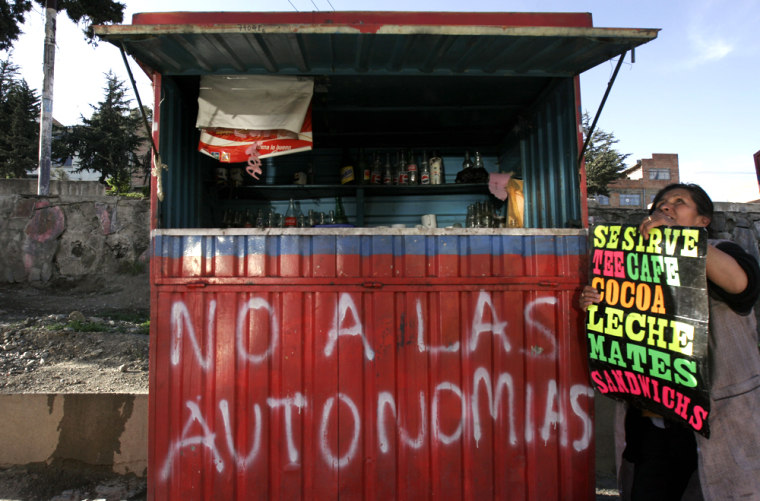Bolivia’s deepening divide is evident outside the Coolors nightclub, where blondes in mini-skirts are waiting to get in, while their boyfriends are having their shoes shined by darker-skinned boys scrambling for their business.
The club-goers are mestizo — Bolivians of mixed European and Indian descent. The boys are Indians whose parents have migrated from the Andes to this wealthy lowland city.
And inside Coolors, the rock singer is screaming invective against Evo Morales, the fiercely left-wing Indian who is leading the field in Sunday’s presidential election, calling him a drug trafficker because he farms coca plants and pledges to decriminalize cocaine.
The steady and combative rise of 45-year-old Morales is an important part of what’s stoking rising calls for autonomy — for business-minded Santa Cruz which fears Morales’ socialist politics, as well as for highland Indians who feel shortchanged by the government.
Hostility growing
There used to be little open hostility between cambas (lowlanders) and kollas (western highlanders), because both sides knew where they stood. But as cambas become more aggressive in their campaign for autonomy from the Andean capital of La Paz, 530 miles away, an undercurrent of racism is becoming more apparent.
“In La Paz it’s all Indians, but here there are beautiful people,” said Gary Mejia, a taxi driver born and raised in Santa Cruz. “People are more closed in the west and they hold lots of protests. In Santa Cruz it’s more peaceful. ... The white people, the cambas, want to work.”
The kollas, of course, also work, and very hard — as peasant farmers in the mountains, or in menial jobs in Santa Cruz, where large-scale agriculture and a bonanza of petroleum and natural gas have swollen the one-time backwater into Bolivia’s largest city with 1.2 million people.
The gap between rich and poor is wide, and many Indians blame it on the country’s free-market policies which they believe enrich the whites. Tens of thousands of kollas have filled their Andean streets and blockaded roads to demand an end to these policies, driving out two presidents in as many years.
Economic gap
In Santa Cruz, which generates a third of Bolivia’s gross domestic product, people worry that Morales as president will make good on promises to take greater state control of the gas industry and redistribute vast lowland plots among the poor.
“We are carrying the country forward,” said Gabriel Dabdoub, president of the Chamber of Industry, Trade, Services and Tourism of Santa Cruz. He says Santa Cruz provides 45 percent of the country’s tax revenues, but receives only 18 percent of the expenditures. That needs to change, he says.
The autonomy question will be addressed next year, when the government holds a convention to rewrite Bolivia’s constitution. Both Morales and his rival for president, Jorge Quiroga, have pledged to bring the issue to the table.
While Dabdoub stresses the argument for autonomy, the radical autonomy group Camba Nation sees a cultural divide, describing Santa Cruz people as hardworking and peaceful, and the highlanders as backward and ornery.
A cultural divide
“There’s racism, of course,” said Sergio Antelo, the mestizo who founded Camba Nation and claims 40,000 members. “But it’s much less — it’s softer — than the harsh racism in the Bolivian Andes (against) white or European society. There’s a radical divide between European culture and Indian culture.”
Santa Cruz has its own Indian population, but most of its citizens are mestizo. More Westernized than La Paz, it’s a city of malls and massive movie theaters — the place where the wealthy send their daughters to train for membership in “Las Magnificas,” a troupe of light-skinned supermodels known throughout Bolivia.
“The regional struggles in both the Andes and Santa Cruz have become polarized over time, and with the election coming up, these positions have become more shrill,” said Camba Nation’s Antelo.
“Depending on the election results, many things could happen — including ethnic, cultural or political confrontations.”
